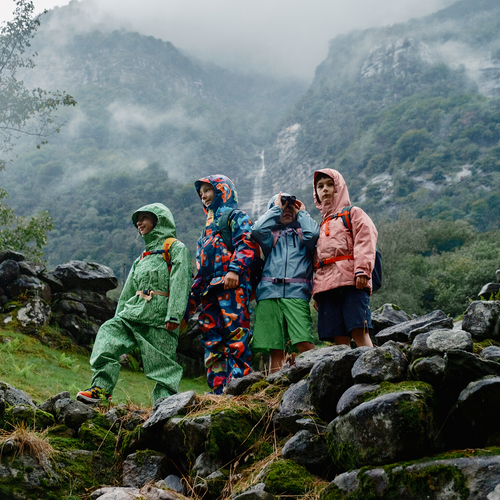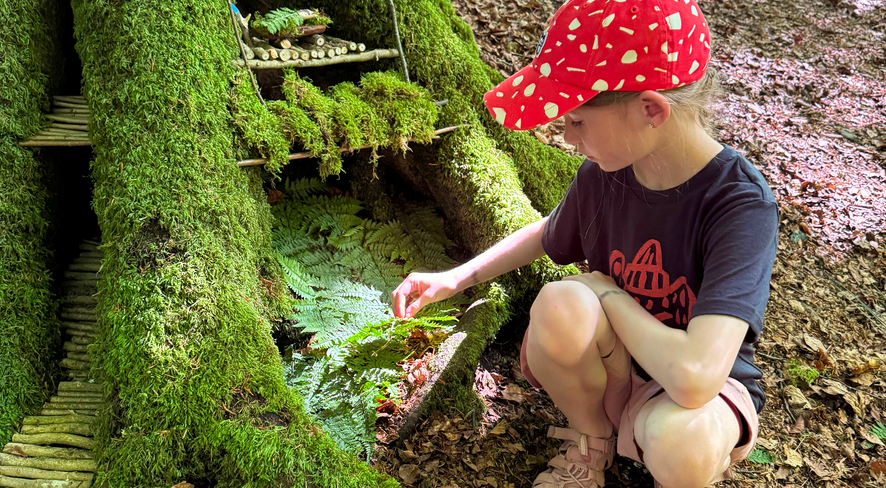Deep in the forest, where light dances through the canopy, roots twist like little bridges from the earth, and moss gently hugs your feet, a special place awaits. A place that smells of adventure – of bark, earth, and imagination. Right here, where the ground is uneven and small caves slumber between the roots, a new home is emerging: for forest dwellers that you can only see with your heart – a gnome's hut.
The idea for it? It's been lingering for a long time, somewhere between childhood memories and LandArt. "Our grandparents probably built gnome huts too," says Gabrielle from kindwaldundwiese. She was inspired by an artist who wedged branches at regular intervals between two tree trunks – like a small ladder to heaven for gnomes. "From that, I derived the idea to build the whole thing horizontally – as platforms."

Following the playful grass hearts, our namuk Ambassador now shares this second passion project with us. A multi-story nature house made of branches, moss, string, and imagination. Built from what the forest provides – and what children's hands and imagination make of it.
Especially around World Environment Day (June 5th), this project reminds us how much we can create without taking anything away from nature. Only with what it freely gives us – and what we transform into something magical with heart, time, and creativity.

A building project for little and big hands
This DIY project is a true family affair. Not in the sense of perfectly planned processes – but because every hand counts, every idea is welcome. "So many different tasks come up, there's something for everyone here," Gabrielle explains. From gathering materials to wedging in the platforms and furnishing: there's space for big and small participants. Whether it's a weekend project or a creative break during a hike – the gnome hut adapts to the pace and composition of your group.

What you need
The main ingredients? Pure nature – and a big dose of imagination.
-
Straight branches and twigs (in various lengths and thicknesses)
-
Moss, leaves, ferns, bark, grasses, flowers
-
Nature treasures like snail shells, acorns, feathers, chestnuts, maple propellers
-
Empty nutshells, small stones, and whatever else you come across on your forest tour
Plus a few practical helpers: garden shears, carving knife, scissors, jute or hemp string. No glue, no wire, no trash – Gabrielle deliberately focuses on sustainability: "We chose a natural string so that the gnome hut can remain standing and other children can enjoy it too."

How it's done: Gnome architecture in seven steps
1. Find the perfect tree: Look for a tree with a widely branched root system. Mossy is a bonus – but not a must.
2. Build platforms: Cut straight pieces of branches with garden shears and wedge them between the root branches. This creates levels where life can move in.

3. Furnish rooms: With moss carpets, fern mattresses, or a small plank floor made of sticks, you can transform the platforms into real gnome rooms.

4. Build paths and connections: Whether it's a rope ladder, a suspension bridge, or simple stepping stones – this requires some skill and patience.
5. Add furniture: A bed made of bark, a small stone table, nutshells as plates, small bouquets of flowers – "Your ideas are needed here. The more colorful, the better," says Gabrielle.

6. A garden is a must: Fences made of twigs, mini flower beds, and small trees transform the area around the house into a paradise.
7. Design paths: Connect all areas with paths and mark them with small stones or stepping plates. The gnome village is complete!

Tips & tricks from the forest
Fancy some practical tips? Then definitely pack more than one pair of garden shears – that saves discussions and waiting times. "Depending on the group, that can significantly reduce frustration," Gabrielle says with a wink. And when building the platforms, it's worth helping out now and then: "It's important that these are reasonably stable and don't collapse every time.“
Just as important as the tools, however, is the right teamwork. "Older children can certainly build platforms themselves," says Gabrielle, "while younger ones might take on the garden design – or, especially at the beginning, just go on a material hunt." This way, the project becomes a success for everyone – regardless of age, experience, or skill.

What emerges? More than just a house
What remains in the end is more than a gnome hut made of branches and moss. It's a collaborative work that connects – outdoors, in doing, in togetherness. "Everyone can contribute in their own way and shine with their talents. Additionally, however, teamwork is also needed," says Gabrielle. And that's exactly what the children experience: what I can do counts – and what we create together, even more so.
While building, the kids playfully learn how important cooperation is. They discover: "Everyone counts in their uniqueness, is valuable, and can make a contribution. That's how it is in real life too," says Gabrielle. And when they return to the little house later, after a thunderstorm for example, it's not just out of curiosity, but out of a genuine sense of responsibility. They helped build it, they belong.

This craft project is incredibly versatile and can be adapted depending on age, motivation, and skill. Both in terms of dimension and detailed work. "The gnome hut project is, so to speak, open-ended in terms of complexity and time required.”
So, get out there! Find your tree, gather materials, and let a new chapter in the story of the small forest dwellers begin. Maybe you'll even meet a real forest gnome?























